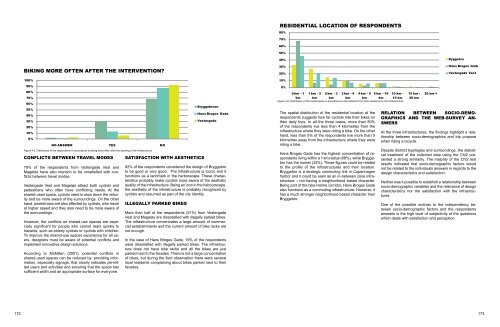Aalborg Universitet Bike Infrastructures Report Silva, Victor ... - VBN
Aalborg Universitet Bike Infrastructures Report Silva, Victor ... - VBN
Aalborg Universitet Bike Infrastructures Report Silva, Victor ... - VBN
You also want an ePaper? Increase the reach of your titles
YUMPU automatically turns print PDFs into web optimized ePapers that Google loves.
RESIDENTIAL LOCATION OF RESPONDENTS<br />
RESIDENTIAL LOCATION OF BIKERS<br />
80%<br />
70%<br />
60%<br />
50%<br />
BIKING MORE OFTEN BIKING MORE AFTER OFTEN THE INTERVENTION?<br />
AFTER THE INTERVENTION?<br />
40%<br />
30%<br />
20%<br />
Byggebro<br />
Hans Broges Gade<br />
Vestergade Vest<br />
100%<br />
90%<br />
80%<br />
70%<br />
60%<br />
50%<br />
40%<br />
30%<br />
20%<br />
10%<br />
0%<br />
NO ANSWER YES NO<br />
Figure 4.5: Distribution of the respondents in accordance to biking more often after the opening of the infrastructure.<br />
CONFLICTS BETWEEN TRAVEL MODES<br />
78% of the respondents from Vestergade Vest and<br />
Mageløs have also mention to be unsatisfied with conflicts<br />
between travel modes.<br />
Vestergade Vest and Mageløs attract both cyclists and<br />
pedestrians who often have conflicting needs. At the<br />
shared-used space, cyclists need to slow down the velocity<br />
and be more aware of the surroundings. On the other<br />
hand, pedestrians are also affected by cyclists, who travel<br />
at higher speed and they also need to be more aware of<br />
the surroundings.<br />
However, the conflicts on shared-use spaces are especially<br />
significant for people who cannot react quickly to<br />
hazards, such as elderly cyclists or cyclists with children.<br />
To improve the shared-use spaces experience for all users,<br />
designers must be aware of potential conflicts and<br />
implement innovative design solutions.<br />
According to McMillen (2001), potential conflicts in<br />
shared-used spaces can be reduced by: providing information,<br />
especially signage, that clearly indicates permitted<br />
users and activities and ensuring that the space has<br />
sufficient width and an appropriate surface for everyone.<br />
SATISFACTION WITH AESTHETICS<br />
Bryggebroen<br />
Hans Broges Gade<br />
Vestergade<br />
82% of the respondents considered the design of Bryggebro<br />
to be good or very good. The infrastructure is iconic and it<br />
functions as a landmark in the harborscape. These characteristics<br />
probably make cyclists more aware of the aesthetic<br />
quality of the infrastructure. Being an icon in the habourscape,<br />
the aesthetic of the infrastructure is probably recognized by<br />
cyclists and assumed as part of the city identity.<br />
ILLEGALLY PARKED BIKES<br />
More than half of the respondents (51%) from Vestergade<br />
Vest and Mageløs are dissatisfied with illegally parked bikes.<br />
The infrastructure concentrates a large amount of commercial<br />
establishments and the current amount of bike racks are<br />
not enough.<br />
In the case of Hans Broges Gade, 19% of the respondents<br />
were dissatisfied with illegally parked bikes. The infrastructure<br />
does not have bike racks and all the bikes are just<br />
parked next to the facades. There is not a large concentration<br />
of bikes, but during the field observation there were several<br />
local residents complaining about bikes parked next to their<br />
facades.<br />
10%<br />
0%<br />
0 km - 1<br />
km<br />
1 km - 2<br />
km<br />
2 km - 3<br />
km<br />
3 km - 4<br />
km<br />
4 km - 5<br />
km<br />
5 km - 10<br />
km<br />
10 km -<br />
15 km<br />
Figure 4.6: Distribution of the respondents in accordance to the distance from their residence to the infrastructure.<br />
The spatial distribution of the residential location of the<br />
respondents suggests how far cyclists ride their bikes on<br />
their daily trips. In all the three cases, more than 80%<br />
of the respondents live less than 4 kilometres from the<br />
infrastructure where they were riding a bike. On the other<br />
hand, less than 5% of the respondents live more than 5<br />
kilometres away from the infrastructure where they were<br />
riding a bike.<br />
Hans Broges Gade has the highest concentration of respondents<br />
living within a 1 km radius (68%), while Bryggebro<br />
has the lowest (33%). These figures could be related<br />
to the profile of the infrastructures and their location.<br />
Bryggebro is a strategic commuting link in Copenhagen<br />
harbor and it could be seen as an in-between zone infrastructure<br />
– not having a neighborhood based character.<br />
Being part of the bike Holme corridor, Hans Broges Gade<br />
also functions as a commuting infrastructure. However, it<br />
has a much stronger neighborhood based character than<br />
Bryggebro.<br />
15 km -<br />
20 km<br />
20 km <<br />
RELATION BETWEEN SOCIO-DEMO-<br />
GRAPHICS AND THE WEB-SURVEY AN-<br />
SWERS<br />
At the three infrastructures, the findings highlight a relationship<br />
between socio-demographics and trip purpose<br />
when riding a bicycle.<br />
Despite distinct typologies and surroundings, the statistical<br />
treatment of the collected data using the Chi2 presented<br />
a strong similarity. The majority of the Chi2 test<br />
results indicated that socio-demographic factors would<br />
not be related to the individuals answers in regards to the<br />
design characteristics and satisfaction.<br />
Neither was it possible to establish a relationship between<br />
socio-demographic variables and the relevance of design<br />
characteristics nor the satisfaction with the infrastructures.<br />
One of the possible motives to the independency between<br />
socio-demographic factors and the respondents<br />
answers is the high level of subjectivity of the questions<br />
which deals with satisfaction and perception.<br />
172 173
















